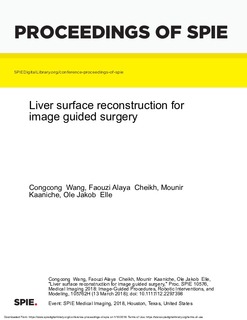Liver surface reconstruction for image guided surgery
Journal article, Peer reviewed
Published version
Permanent lenke
http://hdl.handle.net/11250/2586829Utgivelsesdato
2018Metadata
Vis full innførselSamlinger
Originalversjon
Progress in Biomedical Optics and Imaging. 2018, 1057:105762H6 1-8. 10.1117/12.2297398Sammendrag
In image guided surgery, stereo laparoscopes have been introduced to provide a 3D view of the organs during the laparoscopic intervention. This stereo video could possibly be used for other purposes other than simple viewing: such as depth estimation, 3D rendering of the scene and 3D organ modeling. This paper aims at reconstructing 3D liver surface based on stereo vision technique. The estimated surface of the liver can later be used for registration to preoperative 3D model constructed from MRI/CT scans. For this purpose, we resort to a variational disparity estimation technique by minimizing a global energy function over the entire image. More precisely, based on the gray level and gradient constancy assumptions, a data term and a local as well as a nonlocal smoothness terms are defined to build the cost function. The latter is minimized, by using an appropriate optimization technique, to estimate the disparity map. In order to reduce the disparity search range and the influence of noise, the global variational approach is performed on the coarsest level of the multi-resolution pyramidal representation of the stereo images. Then the obtained low-resolution disparity map is up-sampled with a modified joint bilateral filtering method to the original scale. In vivo liver datasets with ground truth is difficult to obtain, so the proposed method is evaluated quantitatively on two cardiac phantom datasets from Hamlyn Center achieving an accuracy of about 2.2 mm for heart1 and 2.1 mm for heart2. Reconstructed points up to 97% for heart1 and 100% for heart2 are obtained. Qualitative validation on in vivo porcine procedure's liver datasets has shown that our proposed method can estimate the untextured surfaces geometry well.
